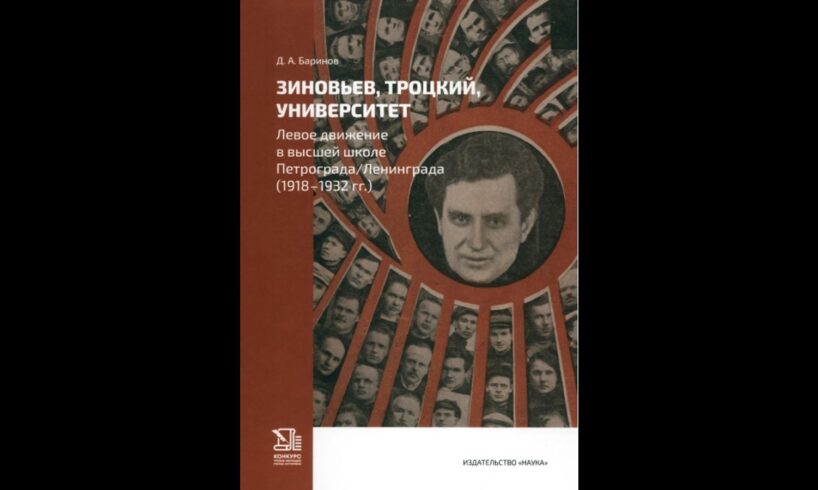
D. A. Barinov, Zinoviev, Trotskii, Universitet. Levoe dvizhenie v vysshei shkole Petrograda/Leningrada (1918-1932 gg.), Sankt-Peterburg, Izdatel’stvo Nauka 2023. 390 pages. Unless otherwise indicated, all page references are to this book.
Dmitry Barinov, a young Russian historian at St. Petersburg State University, has written an important account of the Left Opposition in Leningrad—the name of St. Petersburg at the time—in the years 1923-1932. He has conducted an extensive and meticulous archival research, including in local archives in St. Petersburg and the archive of the Russian Secret Service, FSB, the successor organization of the Soviet secret police, the OGPU, that persecuted the oppositionists. On that basis, Barinov has produced the most extensive account yet of the work of the Opposition in Leningrad, its structure, leading figures and activities among students and the working class.
The cover Barinov’s “Zinoviev, Trotsky, University”
Despite certain weaknesses, Barinov’s work is the most serious contribution to the history of the Opposition from a Russian historian since the works of Vadim Rogovin, whom Barinov appropriately honors as a “pioneer” in this regard. In addition to a thoroughly researched text, it includes a list of 508 names of Oppositionists in Leningrad, with their dates of birth and death and places of employment, as well as illustrations for dozens of them, many never before seen or published. Along with the publication of the newly discovered documents of the imprisoned Opposition from the early 1930s, and several other smaller but important publications, his book testifies to a renewed interest in the history and politics of Trotskyism in the former Soviet Union.
The inner-party struggle in 1923-1924
Barinov centers his account on students and instructors at Leningrad institutions of higher education. The focus on this city is important but also indicates some of the historical challenges involved in his study: Leningrad, previously known as Petrograd, was the city of the 1917 October Revolution, and then the main base of support for Grigory Zinoviev who was widely regarded as a working-class hero in factories in the city. Although he and his supporters later formed a bloc with Leon Trotsky’s Opposition, initially, Zinoviev and his closest political allies, including Lev Kamenev, were bitter opponents of Trotsky.
In 1923-1924, they played a central role in the campaign by the Stalin faction against Trotsky. During the “party discussion” of the winter of 1923-1924, Barinov writes, “thanks to the adamant position of G. E. Zinoviev Petrograd became the place of the most implacable critique of Trotsky.” (p. 67) Although Leningrad had the second largest party organization in the country after Moscow only one signatory of the Declaration of 46, the founding document of the Opposition from October 15, 1923, was from Leningrad.
The Opposition in Leningrad also received significantly fewer votes than in other cities: In Moscow, 40 out of 72 institutions of higher education had majority votes for the Opposition, in Kiev five out of seven party cells at such institutions voted for the Opposition and in Krasnodar, a city in southern Russia, at an all-city assembly of students, 187 out of 193 votes were for the Opposition. By contrast, in Leningrad, only five out of 27 party cells at institutions of higher education had majority votes for the Opposition. (p. 74) An important exception was the Lesnyi Institute (Forestry Institute) which was under less stringent control by the party apparatus. Here, Alexandra Bronshtein (born Sokolovskaia, 1872-1937), Trotsky’s first wife and one of his most loyal political supporters, spoke in the discussions of winter 1923-1924, ensuring a victory for the Opposition in the voting (p. 84).
Alexandra Sokolovskaia with Leon Trotsky in 1902
Based on extensive archival research on the life of the political cells of the party at individual institutions of education in Petrograd, Barinov identifies 55 individuals whom he counts as “politically active” Oppositionists at the time, significantly fewer than in other cities. He also documents the suppression and manipulation of votes. Overall, he counts 1134 party members who voted for the Opposition in Petrograd and 296 abstentions. (p. 77) He concludes
The decisive victory over “Trotskyism” on paper, i.e., [as it was] expressed in the number of votes, did not occur in reality. According to OGPU reports, Trotsky remained popular at many universities, including among non-party students. Opposition supporters realized the futility of speaking out at party cells, understanding that they would not be heard. Therefore, the official results of the discussions did not fully reflect the true attitude toward Trotsky, who remained a symbolic figure for many…(p. 86)
The role of institutions of higher education in the Opposition work
Barinov demonstrates that in Leningrad, instructors and students were the principal organizers of the Opposition. Here, Barinov must be credited with genuinely pioneering archival work. He compiled lists of 508 names of students and instructors who supported the Opposition in Leningrad, and accessed the secret service records for several of them. Given the sheer amount of documents needed to produce this kind of overview and the still significant obstacles in obtaining files from the secret services, he has done the working class and everyone concerned with historical truth an immense service.
The first page of Barinov’s detailed table, listing students at institutions of higher education in Leningrad
Barinov explains that, while the center of the work of the Opposition was in the industrial working class, the agitators, organizers and political leaders were trained and based, primarily, at such institutions of higher education. Students active in the Opposition at this or another university were assigned to work at one particular factory. For instance, Barinov writes,
Students at the Polytechnic Institute had connections with the [factory] “Red Triangle.” Students from the Military-Political Academy conducted agitation at enterprises in the Volodarsky district (the Bolshevik factory and the Lenin factory). University students led circles at the Krasny Gvozdilshchik factory. The tasks of the circles included recruiting new members and collecting signatures for the “Platform of the 83” [of May 1927]. (p. 154)
This work involved several hundreds of students. One of them, N. N. Gavrilov from the Polytechnical Institute, summarized the tasks of lower-ranking Oppositionists as follows:
1. We had to actively defend our views at party meetings.
2. [We had to] distribute the platform of the opposition, print and distribute other documents, compiled by leaders of the opposition.
3. [We had to] collect money needed to buy papers, and to help individual comrades because already they had begun firing people from factories for participation in the opposition.
4. [We had to] establish ties with opposition supporters at factories and institutions of higher education and conduct agitational work there.
5. [We had to] maintain ties with the leadership of the Leningrad opposition group. (Quoted p. 153)
While Barinov does not dwell on this, part of the reason that the Opposition was much stronger in the party cells at universities appears to be that the Stalinist control over factory cells was significantly tighter. Thus, he notes, “In factory collectives, the composition of [party] cells was approached more strictly: candidates from the opposition, were forced to withdraw, even when they enjoyed the unanimous support of their comrades, otherwise their wages were cut or they were temporarily suspended from work.” (p. 132)
Nevertheless, the Opposition was able to organize several major appearances by Opposition leaders before workers of some of the most important factories in Leningrad. Along with political questions, a frequent topic for discussion at such meetings was “the growing social differentiation within the party itself” and the “luxury lifestyle of Soviet bureaucrats”. (p. 133)
The question of generations and political program
Despite an overall objective approach to this history, a serious and persistent weakness of Barinov’s account is that he emphasizes the generational tensions in the party conflict over fundamental questions of political and international perspectives, which he barely discusses at all. In this, he is clearly influenced by historians such as Alexei Gusev and Alexander Reznik, who are affiliated with the Pabloite movement which, in 1953, broke from the Trotskyist movement, rejecting the conception of world socialist revolution carried out by the working class. For the past three decades, in particular, it has been hallmark of the writings of Pabloite historians on the Opposition to downplay or outright ignore the conflict over socialism in one country as opposed to the theory of permanent revolution, as well as the class orientation of the Bolshevik leadership’s economic policy. In Russia and among-Russian speaking historians, their works have enjoyed significant influence.
This is evident in Barinov’s study. While Barinov points to the role of Zinoviev in suppressing support for Trotsky, he does not discuss or even identify the main political issues that were at the heart of the conflict. Instead, echoing the argumentation of Reznik’s, in particular, presents this early stage of the inner-party struggle as primarily centered on generational tensions and the question of inner-party democracy. (For a discussion of Reznik’s distortion of the origins of the Left Opposition see: Alexander Reznik’s Trotsky and Comrades: A false account of the emergence and politics of the Left Opposition)
Like Reznik, Barinov barely even mentions the German Revolution. Instead, he writes, “The main front of the attack on Trotsky in 1923 were his ideas about the role of university students and party youth in general.” (p. 70)
Barinov is, of course, not wrong to stress the immense support for the Opposition at institutions of higher education, above all among students. He points out that 717 of 1430 party cells that voted for the Opposition were at such institutions of higher education. (p. 76) However, the support among party youth cannot be explained in isolation from the history of the Bolshevik Party and the revolution. Party members who attended institutions of higher education at that time were part of a generation that had joined the party in 1918-1920, at the height of a civil war in which most of them fought in the Red Army.
In depth
Leon Trotsky
Leon Trotsky (1879-1940), was the co-leader of the 1917 Russian Revolution, socialist opponent of Joseph Stalin, founder of the Fourth International, and strategist of world socialist revolution.
They joined the Bolshevik party when it had already adopted the theory of permanent revolution. To them, Leon Trotsky was not only the head of the Red Army but also a political leader and strategist, second only to Lenin. By contrast, numerous contemporary accounts testify to the fact that many Old Bolsheviks—who had joined the party before 1917—never fully accepted permanent revolution. While the political conflict thus assumed a generational element, at the heart, it was centered on questions of political strategy and perspective.
These came to the fore, above all, in the fall and winter of 1924, in the campaign by the Stalin faction against Trotsky’s “Lessons of October”, the preface to a volume in his Collected Works, dedicated to his writings from 1917. In “Lessons of October”, Trotsky outlined the conflict in the Bolshevik leadership on the eve of the seizure of power. At the time, Zinoviev and Kamenev headed the party’s right wing, which also included Stalin, and opposed the preparations by Lenin and Trotsky for the seizure of power. Underlying their position was an entirely different conception of the tasks of the revolution.
Since 1905, Trotsky had understood that the bourgeois democratic tasks of the revolution in the Russian Empire could only be resolved by the working class. Despite the relative economic backwardness of Russia, he predicted, the working class would be propelled to take state power and establish a proletarian dictatorship. This dictatorship, however, could only survive if the revolution in Russia was extended internationally. Until early 1917, Lenin, the leader of the Bolsheviks, opposed that perspective. While he also recognized that the liberal bourgeoisie in Russia was not a revolutionary class, he did not consider it possible for the working class to take power alone in such a backward country as Russia. Therefore, he proposed a dictatorship of “two classes”, the working class and the peasantry, in what would still be a bourgeois democratic revolution.
Kamenev, left, and Zinoviev, Old Bolsheviks and close collaborators of Lenin, oppose the insurrection
But Lenin shifted course after the overthrow of the Tsarist regime in the February revolution of 1917: As soon as he returned to Russia in April 1917, he declared that the Bolsheviks now had to prepare for a second, socialist revolution and the seizure of power by the working class. Zinoviev, Kamenev and Stalin opposed this shift. Their main orientation in February-March 1917 was toward cooperating with the bourgeois government of Alexander Kerensky. They were still convinced that the revolution in Russia could not be socialist. As late as September 1917, Zinoviev, in particular, objected against the seizure of power as being “premature.” In Lessons of October, Trotsky characterized the essence of the conflict between these two different tendencies in the party leadership as follows:
One of these tendencies, the main one, was proletarian and led to the path of world revolution; the other was ‘democratic’, petty-bourgeois, and ultimately subordinated proletarian politics to the demands of a reformist bourgeois society. These two tendencies clashed bitterly over all issues of any substance throughout 1917. It is precisely the revolutionary era, i.e. the era when the party uses its accumulated capital, when these kinds of disagreements must be exposed in action. These two tendencies will reappear in the revolutionary period of all countries to a greater or lesser degree and with one or another deviation.[1]
Defeated in the inner-party struggle in 1917, this national-reformist wing in the party leadership was strengthened amidst the international isolation of the revolution, the death of Lenin in early 1924 and the consolidation of a privileged bureaucratic caste in Soviet society. The aborted German Revolution in 1923 played a decisive role in this regard. After a 5-year long period, during which Soviet workers and farmers had fought heroically to defend and extend the conquests of the revolution, it was now clear that the revolution, above all in the advanced imperialist countries, would take longer than anticipated.
This shift underlay the embittered attacks on Trotsky’s theory of permanent revolution and his “Lessons of October”. Exploiting their prestige as long-time collaborators of Lenin, Zinoviev and Kamenev played a particularly aggressive role in this campaign and sought to lend credibility to the claim that Bolshevism was fundamentally distinct from what they termed “Trotskyism.” In an article for Pravda, the party’s leading newspaper, on November 30, 1924, Zinoviev emphatically denied that there ever had been a “right-wing” in the Bolshevik party. He then went on to accuse Trotsky of a “rightist deviation”, and a long history of expressing “non-Bolshevik moods” and “opportunistic errors.”[2]
The essentially nationalist-reactionary content of these attacks on Trotsky was revealed by Stalin in his December 1924 declaration that the party had now to orient toward “building socialism in one country.” The central role of Zinoviev and Kamenev in this campaign explains the great hesitancy among Trotsky’s supporters over his decision in 1926 to form a bloc with Zinoviev and Kamenev. But the fundamental issues involved in this struggle are also the principal basis for understanding why Trotsky, eventually, decided to form this bloc.
The United Opposition, 1926-1927
Barinov has engaged in impressively detailed research into the formation of the United Opposition Bloc which has, so far, received remarkably little attention in the historiography.
He shows in considerable detail how, in Leningrad, in particular, many rank-and-file members and also leaders of the Opposition opposed the formation of a bloc with Zinoviev and Kamenev. Nina Nevelson (1902-1928), Trotsky’s younger daughter, as well as the leading Trotskyist Boris Eltsin (1876-1937) were among those sent to negotiate with the Leningrad Opposition for agreement on the bloc.
Nina Nevelson (1902-1928)
However, as in other parts of his book, Barinov barely gives a political explanation for this new stage in the work of the Opposition and merely dismisses the bloc “as artificial in character, fragile and unstable.” (p. 118)
As a matter of fact, Trotsky himself was, initially, amazed at the emergence of a fundamental rift between Zinoviev and Stalin, which centered on the Leningrad party organization and violently erupted into the open at the 14th Party Congress in December 1925. Having been systematically excluded from many key political discussions and decisions at the Politburo-level, his initial response was to observe. Eventually, however, he concluded that the turn-about-face by Zinoviev reflected, above all, a shift in the moods of the Leningrad workers who were opposed to the conception of building “socialism in one country” and disquieted by the strengthening of the wealthiest layers of the peasantry as a result of the policies of Joseph Stalin and Nikolai Bukharin.
Grigory Zinoviev in 1920
Moreover, the opposition by two of the most prominent Old Bolshevik leaders and closest collaborators of Lenin to Stalin helped disprove the myth that Trotsky had always opposed the Leninist leadership. Lastly, minutes of critical Politburo sessions in the spring and summer of 1926, that were published in Russian in 2007, make clear that the Stalinist betrayal of the British General Strike played a central role in the formation of the bloc. While Trotsky was never under the illusion that the fundamental political differences with Zinoviev and Kamenev over permanent revolution had been overcome, the bloc was an essential component of politically clarifying and educating broader layers of the working class and party membership and consolidating the socialist opposition to Stalin as a tendency.
Although Barinov dismisses the political basis of the bloc, the empirical material he presents, in fact, demonstrates that Trotsky’s considerations were correct. The formation of the bloc was bound up with the initiation of systematic and highly structured underground work by the Opposition and the recruitment and training of a much larger layer of Oppositionists among workers and youth than had previously been possible.
In no small measure, this was a response to the escalating crack-down on the Opposition by the Stalin leadership. In Leningrad, Stalin sought to effectively topple the Zinovievite leadership of the party organization. Zinoviev would later describe the state of the city in the months leading up to the formation of the bloc with Trotsky as edging on a “civil war.” The editorial boards of the city’s most important party newspapers, Leningradskaia Pravda and Krasnaia Gazeta, were dismissed and then staffed with Stalinist loyalists. A stunning 7,184 party workers from Leningrad were purged and relocated to other cities. (p. 112)
In Moscow, too, the crack-down escalated. In one district, 90 percent of the organizers of party cells were removed, 65 percent of the staff of party cell bureaus were purged. Most of them had been from the Leningrad organization. For those fired, finding new employment was often difficult. But this crackdown also encouraged the growth of the Opposition which, upon the formation of the bloc, became much better organized. Barinov writes,
Unable to be heard, many of those who had previously limited themselves to voting for the opposition became participants in the nascent movement. Joining the opposition provided an opportunity to find like-minded people and, at the same time, opened up prospects for participation in real social and political work, independent of the will of the party leadership. The role of students and teachers in Petrograd-Leningrad in the discussions was noticeable, and in 1923 even key universities proved to be extremely receptive to the opposition agenda. (p. 114)
Based on archival records of the OGPU, Barinov was able to reconstruct the structure of the Opposition underground in 1926-1927. The leadership consisted of a “city center” which oversaw the work of district “troikas” (group of three) and “piatiorkas” (group of five). These troikas and piatiorkas in turn organized the work of cells of party collectives which usually consisted of about three and at large factories of five people. According to Barinov, “one part of the activists worked openly, i.e., they spoke at cell meetings, signed documents, and voted, whereas the other part stayed in the shadows.” (p. 123) In many respects, as Barinov observes, this structure duplicated the modus operandi of the Bolshevik underground under the Tsarist regime.
The political differences between Zinoviev and Trotsky were reflected in a constant struggle for influence between Trotskyist-led groups and Zinovievist-led groups which, in Leningrad, were the majority. In some districts, this even meant that the leadership structures were duplicated. According to Barinov, tensions especially at the middle and lower level were so high that a merger of the groups, proposed by the Opposition leadership in the spring of 1927, was vehemently rejected.
An image of the leading Oppositionist Fedor Dingelshtedt, published for the first time in Barinov’s book
The work of the Trotskyists in Leningrad was headed, above all, by Nikolai Karpov (1894-1973), Fedor Dingelshtedt (1890-1943), Grigory Yakovin (1897-1938) and Alexandra Bronshtein, all of whom were at the time teaching at institutions of higher education. Other important figures Barinov highlights include Isaak Alter (1892-1937), who had joined the revolutionary movement in Poland, his wife at the time, Olga Tankhilevich (1900-1963), Boris Kurzhnir (1896-after 1956) and Olga Lifshits (1881-1939), both from Switzerland, and Zakhar Zabludovsky (1899-1941), also from Poland.
An image of the Leningrad Oppositionist Olga Lifshits, published for the time in Barinov’s book
The underground work of the Opposition in 1928-1932
Among the most remarkable findings of Barinov is that the Opposition in Leningrad was able to continue underground activities of the Opposition well after its expulsion from the party at the 15th Party Congress in December 1927 and the arrest of Trotsky and most of the best-known Opposition leaders. He writes,
The structure of the underground opposition movement was similar to that of 1926–1927, but became more compact. The city opposition was headed by the “Political Center” (consisting of three people), which was subordinate to the city center, which included representatives of district branches that were engaged in propaganda at large enterprises. They were assisted by agitators who, as before, stood outside the main structure. All members of the opposition were obliged to pay dues and collect donations. According to the investigation materials, the movement was led by I. M. Alter (nicknamed “Aleksey”), a teacher at the Herzen State Pedagogical Institute, economist V. K. Lenkov, and V. G. Densov, who had arrived from the Ukrainian SSR after being expelled from the party. …Alter had connections with Moscow oppositionists and sent them materials for the Opposition Bulletin. …. A total of 150-200 people, mainly workers, were under their influence.” (p. 207)
A mass raid by the OGPU in December 1928 resulted in the arrest of the principal leaders, Alter and Yakovin, the destruction of their four printing presses, library and stacks of some 15,000 leaflets. Nevertheless, Barinov found, “Even after the mass arrests at the end of 1928, the movement was able to regroup and continue its work.” (p. 220).
He continues,
The last surge of underground work was connected with Trotsky’s expulsion in February 1929. It was perceived as the betrayal of the leader of Bolshevism to enemies in the West, posing a threat to his life. Hopes were pinned on organizing workers’ demonstrations, and about a thousand leaflets were prepared on three mimeograph machines for propaganda purposes. This was the last notable mass action of the Leningrad opposition. In January–March 1929, 25 oppositionists were imprisoned. (p. 221)
After this raid, the Opposition work was led primarily by students from the Medical Institute and Military-Medical Academy. Their leader was a certain Aleksandr Moiseevich Shulder (1903-1974) who, according to Barinov, “had ties with supporters [of the Opposition] abroad”. The OGPU put an end to this Opposition branch and, thereby, much of the Opposition underground in the city, with the arrest of over a dozen medical students in December 1930-March 1931. Barinov notes that, yet again, the work of the Opposition in Leningrad was weaker than in other parts of the Soviet Union. Thus, protests organized by the Opposition took place in cities such as Moscow, Kiev and Kharkov, well into the early 1930s. In Leningrad, however, this was not the case.
The question of inner-party democracy and the Democratic Centralists
While Barinov provides an enormous amount of important information on the United Opposition and leading Trotskyists, his own political sympathies and emphasis lie with a third tendency that was involved in the Opposition: The Democratic Centralists.
Formed already during the first stages of the civil war that followed the October Revolution, the Democratic Centralists were headed by Timofei Sapronov and had their principal base of support in Ukraine. During the civil war, they criticized the Lenin-Trotsky leadership from an ultra-left standpoint, opposing, for instance, the inclusion of experts into the army and economic leadership. They also raised, early on, criticism of the beginning bureaucratization of the party. In the fall of 1923, the supporters of Trotsky and the Democratic Centralists united in a political bloc to issue the Declaration of 46 (October 15, 1923). In Petrograd, the sole signatory of the Declaration of 46 was Taras Ivanovich Kharechko (1893-1937), a Democratic Centralist, party member since 1914 and civil war hero in the Donbass.
Taras Kharechko (1893-1937), Democratic Centralist and signatory of the Declaration of the 46
In contrast to Trotsky and similar to Zinoviev, the Democratic Centralists never accepted permanent revolution and focused their criticism of Stalinism on two domestic issues: The erosion of inner-party democracy by the bureaucracy, and its incorrect economic policies. Approaching these issues from a national standpoint, already by 1926 the Democratic Centralists had concluded that the revolution had been conclusively betrayed and that a second party had to be formed. They also developed an early version of the conception of “state capitalism,” describing the bureaucracy as a new ruling class.
The bloc between the Trotskyists and the Democratic Centralists was, if anything, even more unstable than that with the supporters of Zinoviev. In late 1926, the Democratic Centralists abandoned the bloc because they opposed a tactical retreat but later temporarily rejoined it.
Barinov emphasizes the role of the Democratic Centralists in Leningrad, even while acknowledging that they were a small minority in the Opposition there. He praises their views as being free of the “party fetishism” that he sees in the positions of Trotsky and Zinoviev. While it is certainly Barinov’s right to sympathize with the Democratic Centralists, it is a serious omission that he does not inform his readers of the well-documented assessment by the Trotskyists of the Democratic Centralists. Given their, at times, ferocious opposition to the party leadership during the civil war, Trotsky was compelled, early on, to evaluate this tendency.
In his assessment, the Democratic Centralists reflected, on the one hand, petty bourgeois radical layers in the party and, on the other, the insecurity of sections of workers who were afraid of being rapidly betrayed of the hard-won gains of the revolution. Although these two tendencies had a different class basis, they were united in their impressionistic impatience and lack of a strategic internationalist orientation. In a letter from May 1928, Trotsky opposed the Democratic Centralists’ assessment that the revolution had already been betrayed by noting that they are “bent to accept the overture for the opera, that is to say, to assume that all the basic processes in the Party and in the State have already been accomplished; and that Thermidor, of which they heard for the first time from us, is an already accomplished fact.”[3]
The Democratic Centralists continued to exert influence in the Opposition well into the early 1930s. Given that they did reflect a persistent tendency within the Soviet working class, the Trotskyists made a point of both sharply criticizing their mistakes and appealing to their working-class supporters. In one of the documents that were found in the Verkhne-Uralsk political isolator from 1932, the Soviet Trotskyists stressed the national orientation of the Democratic Centralists, writing,
The attempt to escape the contradictions of the transitional period within national frameworks, to build an ideal, isolated national workers’ state; to eliminate bureaucracy once and for all by means that would, by their very nature, provide an absolute guarantee against the degeneration of the vanguard and ensure crisis-free development within national frameworks, is a petty-bourgeois utopia, long since outlived in the course of the workers’ movement and representing only the ultra-left anarcho-syndicalist flip side of Stalinist National Socialism.” [4]
The cover of the pamphlet “The Crisis of the Revolution and the Tasks of the Proletariat.” Source: Tetradi Verkhne-Uralskogo politicheskogo izolatora
At the same time, they stressed that among those influenced by Democratic Centralism were not only radical intellectuals “who were increasingly breaking with Marxism and the world revolution,” but also “many outstanding proletarian revolutionaries” who were disoriented by the opportunist policies of Stalinism. Therefore, the task of the Opposition was to expose the former and convince the latter of the correctness of the Trotskyist line.[5]
Barinov mentions the finding of these documents but does not deal with their contents. His general emphasis on the democratic questions in the opposition to Stalinism is bound up with an indifference to fundamental programmatic issues and questions of the world revolution. This, inevitably, blurs the lines between the different tendencies within the opposition.
Thus, he simply ignores Trotsky’s many statements about the conditional character of inner-party democracy which he always viewed as subordinate to questions of the world proletarian revolutionary strategy. Moreover, his approach blurs the lines between the Trotskyist Opposition and various Menshevik-influenced and anarchistic opposition tendencies among students to which Barinov devotes the entire first chapter as if there was a direct line between them and the later Left Opposition. On all of these points, Barinov’s approach mirrors that of the Pabloite historian Alexei Gusev, the viciously anti-Trotskyist Simon Pirani and, more recently, Alexander Reznik, who have sought to elevate the Democratic Centralists over Trotsky as the opposition to Stalinism.
Conclusion
Despite its weaknesses, Barinov’s book ranks as one of the most important contributions to the history of the Left Opposition. It towers over those of recent Pabloite historians with its sheer wealth of material, based on meticulous and assiduous research, and a sincere commitment to establishing an accurate and precise historical record of the struggle of the Left Opposition. His book is an indication of both the immense wealth of material on the history of the Trotskyist movement that is contained in the Russian archives, and a renewed interest in this history which was fueled, not least of all, by the finding of the seminal documents of the Soviet Trotskyists from the early 1930s. We shall hope that his book finds a wide readership, and helps stimulate further, politically vital research into one of the most complex and important chapters in the history of Marxism and the social revolution.
David North in Prinkipo
A tribute to Leon Trotsky
David North visited Trotsky’s final residence during his exile (1929-33) on the island of Prinkipo, and paid tribute to the life of the great theorist of world socialist revolution.





